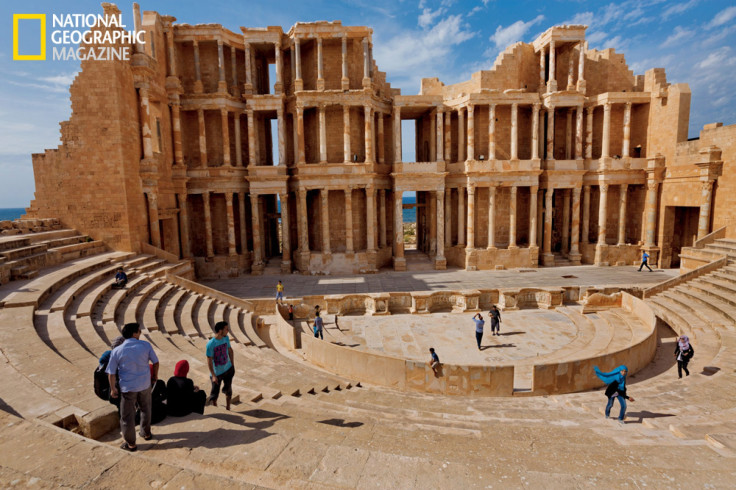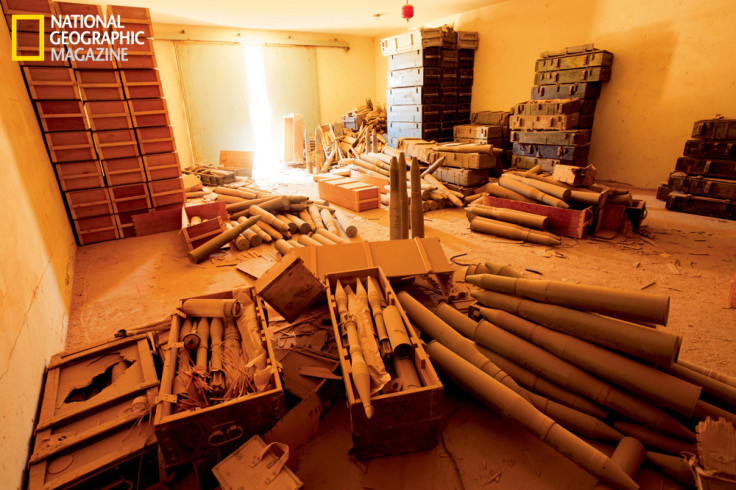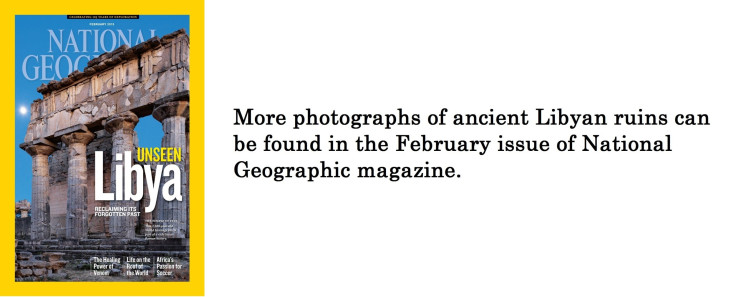Ancient Rome In Libya: A Suppressed History Resurfaces After Revolution [PHOTOS]


In the North African country of Libya, some of the world’s most well-preserved ruins from the ancient empires of Greece and Rome have been hidden in plain sight for the past four decades.
Before that, they were even harder to find -- desert sands had kept the relics buried for centuries until Italian archeologists dug them up during the early 20th century.
But late Libyan leader Moammar Gadhafi found another, more subtle way to bury Libya’s storied heritage. He simply ignored it, choosing instead to build a legacy that divorced Libyans from their ties to other civilizations. Now, as Libya rebuilds itself in the aftermath of the bloody Arab Spring revolution of 2011, it may be time once more to unearth some of the oldest foundations of the Libyan state.
“What Gadhafi did was reconfigure Libyan history and place himself squarely in the center of it,” said Robert Draper, an American correspondent for National Geographic magazine who has traveled extensively throughout Libya to investigate its post-revolution progress. “In so doing, he marginalized Libya’s glorious past and gave Libyans a sense of country that really was divided into two parts: the time of Western domination followed by the time of liberation, courtesy of Gadhafi.”
Now that the dictator is gone, scholars and archaeologists have a fresh chance to rewrite history one more time.
This Land Is My Land
Berbers were occupying the area we now call Libya when, around the fifth century B.C., Phoenicians moved in to establish communities along the coastline, and the Greeks colonized areas of what is now eastern Libya.

Around the beginning of the first century A.D., the Romans began to stake their own claim to the area, eventually turning northern Africa into a prominent arm of the empire. In fact, Libya was the homeland of the emperor Septimus Severus, who ruled the empire between 193 and 211 A.D. Hubs of trade and scholarship in Libya -- including the municipalities of Leptis Magna, Sabratha and Oea that formed the three-city zone, or tripolis, that would give the modern capital city of Tripoli its name -- flourished under centuries of Roman leadership.
The next conquerors were the Arabs, who established Islam as the region’s most prominent religion beginning in the seventh century. Ottomans took over during the 16th century, and their rather detached stewardship of Libya officially ended in 1912 when Italian colonizers rolled in. It was during this period that teams of archeologists dug up some of the ancient ruins that had been interred after centuries of neglect. Benito Mussolini himself visited the sites and was particularly fond of the Roman theaters of ancient Sabratha.
The end of World War II brought a brief period of British and French administration before Libya gained independence in 1951. The first ruler of this new state was King Idris I, who was overthrown by Gadhafi in 1969.
This incredible history has left Libya with a unique cultural inheritance, including five Unesco World Heritage Sites.
“Under the [Gadhafi] regime, there was no particularly serious damage to those sites. But there was a lack of maintenance and sometimes not enough protection,” said Karim Hendili, a program specialist at the United Nations Educational, Scientific and Cultural Organization, or Unesco. “During the revolution, we were very concerned; there was an appeal to the forces in Libya to pay attention to the heritage. But there was no massive damage. The sites were not located next to the fighting.”
Portions of Leptis Magna, for instance, are still remarkably well-preserved. So are the amphitheater at Sabratha, the aged columns at Cyrene, the oasis city of Ghadames and -- older still -- the cave paintings at Tadrart Acasus.

A Different Kind Of King
Gadhafi’s disdain for Greco-Roman legacies is in some ways understandable. The story of ancient societies is a story of ongoing foreign conquests, something the Libyan leader outwardly disparaged. For him, the threat of Western imperialism was a constant rhetorical theme -- and an ironic one, considering Gadhafi’s own lust for far-reaching authority. He used targeted investments to shore up support for his regime across the continent and referred to himself as the King of Kings of Africa.
Under Gadhafi, Libya thrived economically. This was due largely to the discovery of oil reserves in 1959, which spurred unprecedented growth and rapid development. Despite being poverty-stricken for the first half of the 20th century, Libya’s achieved a GDP per capita of more than $12,000 in 2010, the last year of Gadhafi’s reign. Of the 187 nations measured by the United Nations Development Program, Libya ranks at 64th in terms of human development -- better than any other country on the African mainland.
But Gadhafi is better known for his capricious behavior and exploitative governing style. He held power for 42 years, despite having never been elected to lead the country. Political dissent was suppressed with a heavy hand, though Gadhafi had no qualms about funding Islamist militant groups in foreign countries.
The dictator looked to Africa and the Middle East first and foremost in terms of diplomatic partnerships, turning his back on the West despite the Libya’s proximity to Europe. So it is no surprise that the ancient ruins prided by Italian conquerors were neglected by Tripoli for so many decades.
Today, the evidence is scattered throughout the country. A Christian Cathedral built by the Italians during the 1930s now sits disused and crumbling in Benghazi. Pieces of Roman ruins rest unprotected in the regions surrounding the eastern coastal town of Al Bayda. A bronze statue of Septimus Severus, once installed by Italians in the center of Tripoli, was dismantled by the Gadhafi regime -- Draper stumbled upon that historical treasure where it had been surreptitiously stowed for years in the backroom of a museum.

“Some archaeological groups, both locally and throughout the world, have been trying to seize the moment and preserve the antiquities that went to seed under the Gadhafi regime,” Draper said. “The problem is that there’s no money in the Libyan government, and the additional problem is that there’s barely a Libyan government at all.”
Deep Roots
Scholars and historians are eager to put the pieces back together.
“We now have a Unesco antennae open in Libya,” Hendili said. “Colleagues are working there with the new decision-makers to promote policies for the protection of heritage.”
But the fact remains that most people in Libya are too preoccupied to think much about the restitution of centuries-old structures. People are suffering as the country cobbles itself together, and the challenges are great.
The population is still reeling from the 2011 clashes that pitted revolutionaries against the regime, which resulted in thousands of deaths. Gadhafi was killed in October 2011, but Libya’s troubles were far from over. Still today, the government is struggling to enforce order and implement reforms.

Libya is overflowing with weapons, and many of the militias that formed to topple Gadhafi have now taken it upon themselves to police their communities, undercutting government security forces and making it more difficult for Tripoli to maintain order. There are also extreme Islamist groups who have perpetrated attacks on various targets, including Sufi shrines and mosques, provocative art exhibits and the American consulate in Benghazi where U.S. Ambassador Christopher Stevens and three other Americans lost their lives.
In an atmosphere like this, it is understandable that the preservation of ancient ruins might take a backseat.
But these ancient sites are about more than historical nostalgia -- their preservation could benefit Libyan society in a very real way. The relics would attract scholars and tourists to post-revolution Libya, which could raise revenues and help the once-isolated state make new connections with the international community.
“These Greco-Roman ruins truly are among the most pristine in the world, and that has an economic benefit that Libya could certainly tap into,” Draper said. “The less quantifiable benefit has to do with what those sites say about Libyans’ own heritage and their own identity. It’s a reminder not only that these great civilizations once were there in Libya, but that Libya was very much a part of the connective tissue across the Mediterranean.”
Images Courtesy of National Geographic. See more online here.

© Copyright IBTimes 2024. All rights reserved.






















